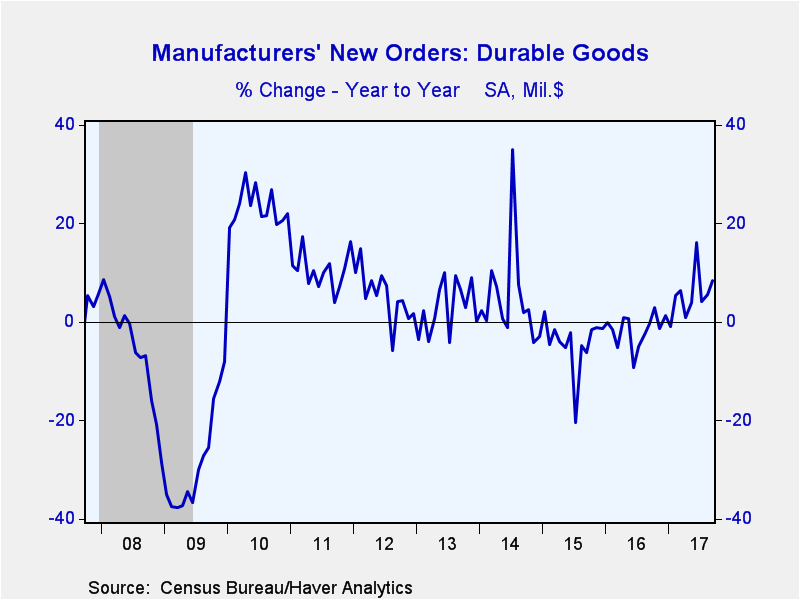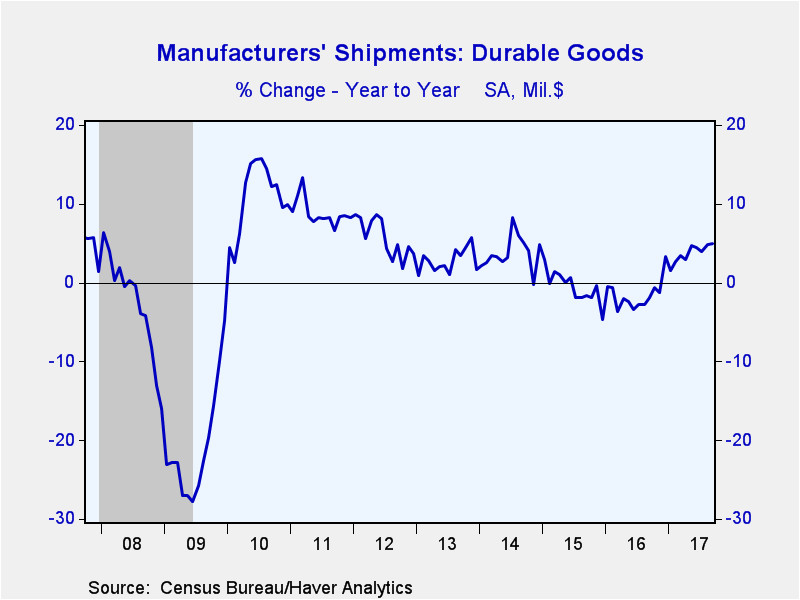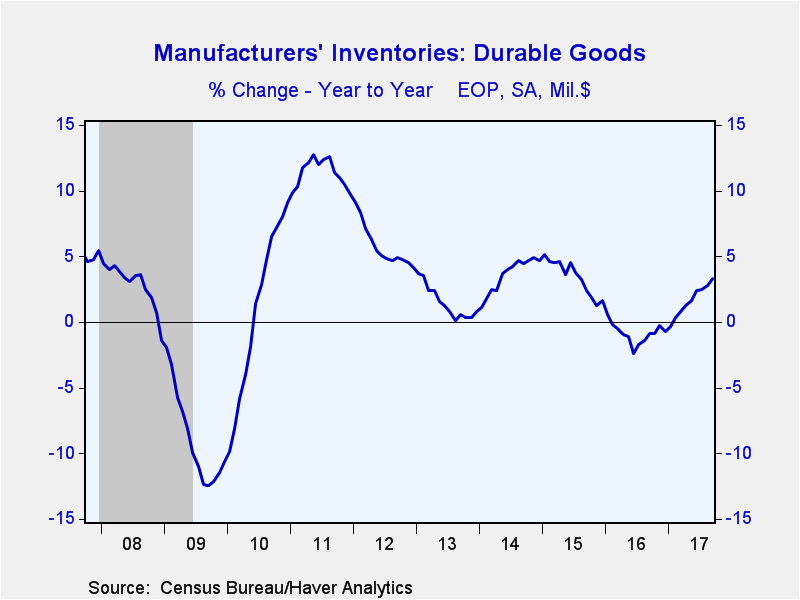 Global| Oct 25 2017
Global| Oct 25 2017U.S. Durable Goods Orders Are Strengthened by Aircraft Bookings
by:Tom Moeller
|in:Economy in Brief
Summary
New orders for durable goods increased 2.2% during September (8.3% y/y) following an unrevised 2.0% August gain. A 1.2% increase in orders had been expected in the Action Economics Forecast Survey. The rise in orders reflected a 5.1% [...]
New orders for durable goods increased 2.2% during September (8.3% y/y) following an unrevised 2.0% August gain. A 1.2% increase in orders had been expected in the Action Economics Forecast Survey.
The rise in orders reflected a 5.1% increase (10.0% y/y) in transportation sector bookings following a 4.7% gain. Nondefense aircraft & parts orders strengthened by roughly one-third for the second straight month and motor vehicle & parts orders were little changed (2.3% y/y). Excluding the transportation sector, durable goods orders improved 0.7% (7.5% y/y), about as they did during the prior two months. During the last three months, these orders have risen at a 9.4% annual rate, the quickest growth rate since January.
Nondefense capital goods orders strengthened 6.1% (14.6% y/y) due to the increase in civilian aircraft orders. Orders excluding aircraft rose 1.3% (7.8% y/y) for the third consecutive month.
Machinery orders eased 0.2% (+7.0% y/y) about as they did in August. Electrical equipment bookings slipped 0.1% (-1.9% y/y) after a 1.7% jump. Remaining strong were orders for computers & electronic products which jumped 1.6% (6.7% y/y), the third straight month of firm increase. That strength has been powered by communication equipment orders which rose 4.8% in September and by roughly fifty percent (AR) during the last three months. Orders for computers & related products declined 5.5% (+7.9% y/y) last month, off for the second straight month. Primary metals orders slipped 0.1% (+12.5% y/y) after a 1.4% rise, but orders for fabricated metals strengthened 1.7% (13.8% y/y) following a 0.3% gain.
Shipments of durable goods increased 1.0% (5.0% y/y) last month after a 0.7% rise. Shipments outside of the transportation sector rose 0.8% (6.7% y/y) after a 1.2% increase. Unfilled orders for durable goods gained 0.2% (1.4% y/y) following two months of slight decline. Backlogs outside of the transportation sector rose 0.3% (4.3% y/y) after a 0.4% rise. Durable goods inventories gained 0.6% (3.3% y/y), the largest monthly increase in just over two years. Outside of transportation, inventories rose 0.6% (5.0% y/y) the same as in August.
The durable goods figures are available in Haver's USECON database. The Action Economics consensus forecast figure is in the AS1REPNA database.
| Durable Goods NAICS Classification | Sep | Aug | Jul | Sep Y/Y | 2016 | 2015 | 2014 |
|---|---|---|---|---|---|---|---|
| New Orders (SA, %) | 2.2 | 2.0 | -6.8 | 8.3 | -1.7 | -4.6 | 4.7 |
| Transportation | 5.1 | 4.7 | -19.6 | 10.0 | -3.4 | -6.2 | 8.2 |
| Total Excluding Transportation | 0.7 | 0.7 | 0.8 | 7.5 | -0.7 | -3.6 | 2.9 |
| Nondefense Capital Goods | 6.1 | 4.0 | -19.7 | 14.6 | -7.1 | -11.0 | 0.9 |
| Excluding Aircraft | 1.3 | 1.3 | 1.3 | 7.8 | -4.6 | -4.3 | 0.3 |
| Shipments | 1.0 | 0.7 | 0.1 | 5.0 | -1.6 | -0.6 | 3.8 |
| Unfilled Orders | 0.2 | -0.0 | -0.3 | 1.4 | -1.7 | -2.0 | 8.3 |
| Inventories | 0.6 | 0.5 | 0.5 | 3.3 | -0.7 | 1.6 | 4.7 |
Tom Moeller
AuthorMore in Author Profile »Prior to joining Haver Analytics in 2000, Mr. Moeller worked as the Economist at Chancellor Capital Management from 1985 to 1999. There, he developed comprehensive economic forecasts and interpreted economic data for equity and fixed income portfolio managers. Also at Chancellor, Mr. Moeller worked as an equity analyst and was responsible for researching and rating companies in the economically sensitive automobile and housing industries for investment in Chancellor’s equity portfolio. Prior to joining Chancellor, Mr. Moeller was an Economist at Citibank from 1979 to 1984. He also analyzed pricing behavior in the metals industry for the Council on Wage and Price Stability in Washington, D.C. In 1999, Mr. Moeller received the award for most accurate forecast from the Forecasters' Club of New York. From 1990 to 1992 he was President of the New York Association for Business Economists. Mr. Moeller earned an M.B.A. in Finance from Fordham University, where he graduated in 1987. He holds a Bachelor of Arts in Economics from George Washington University.










